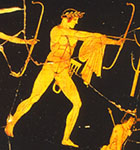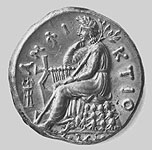Apollo



A god, son of
Zeus and Leto, with his twin
Artemis. He is the god of the major sanctuaries on
Delos, and at
Delphi, where he gave 'oracles', answering questions set him by any visitor on either personal or state affairs, and saw to the purification of, for example,
Orestes. To the Greeks he represented the Rule of Law. He is often shown with a bow,
lyre or
kithara, and laurel wreath or branch, and is bearded only in early Archaic art. With his sister
Artemis he fights against
Herakles (stealing his Delphic
tripod), they kill the children of
Niobe (who boasted of the size of her family), and support the Trojans in the Trojan War. He is the god of music, and later he is especially associated with the
Muses.
Above left: Apollo killing Niobes. Detail from an Athenian red-figure clay vase, about 475-425 BC. Paris, Musée du Louvre G341 © Musée du Louvre, Paris Licence Plate 11 UK 1007 112
Above middle: Apollo with Muses in a chariot. Detail from a 'Melian' (Parian) amphora from Melos. Athens 3961. © Athens, National Museum Licence Plate 11 UK 1007 113
Above right: Phocis Locris coin Rev. Delphi, c. 336 BC. Athens © Kraay and Hirmer pl. 147,462


